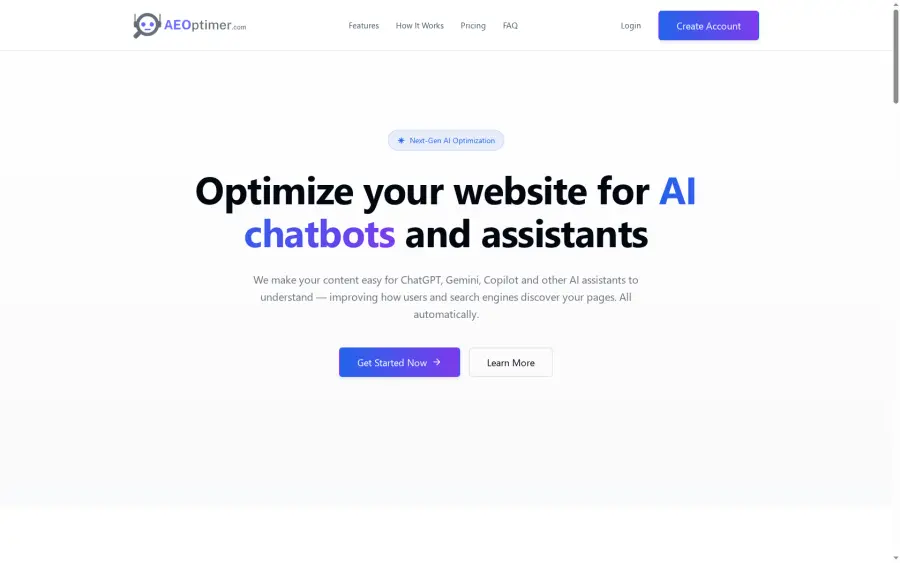Website Accessibility for AI: Complete Guide 2024

More than 60 percent of american websites lack the technical structure for full AI accessibility, putting businesses at risk of being invisible to intelligent search tools and conversational assistants. As digital platforms evolve, ensuring that artificial intelligence can seamlessly interpret and interact with web content matters more than ever. This article reveals practical steps that help websites become not just human friendly but also smart, adaptable, and visible in the expanding world of AI-driven discovery.
Table of Contents
- Defining Website Accessibility For AI
- How AI Interprets And Accesses Websites
- Automation And Structured Data Enhancements
- Ensuring Compliance With Search And AI Standards
- Maximizing AI Discoverability And Avoiding Pitfalls
Key Takeaways
| Point | Details |
|---|---|
| Importance of AI Accessibility | Websites must be designed for AI interpretation to enhance discoverability, usability, and engagement across digital platforms. |
| Key Technical Components | Implementing structured data, semantic HTML, and comprehensive metadata is essential for enabling AI systems to comprehend web content effectively. |
| Compliance with Standards | Adhering to AI and web accessibility standards ensures that websites are inclusive and facilitate better interaction for both users and AI systems. |
| Strategies for Maximizing Discoverability | Employing advanced semantic markup and clear content hierarchies will enhance AI’s ability to evaluate and prioritize web content accurately. |
Defining Website Accessibility for AI
Website accessibility for AI represents a critical technological frontier where digital platforms are intentionally designed to be comprehensively interpretable and navigable by artificial intelligence systems. According to research from Cast.org, this emerging field emphasizes developing inclusive technologies that enable AI to understand, analyze, and interact with web content seamlessly.
At its core, AI website accessibility involves creating digital environments that allow artificial intelligence tools to efficiently process, comprehend, and extract meaningful information. As highlighted by IJISAE, this requires technologies that are not just technically functional, but adaptable and configurable to meet diverse computational interpretation needs. Key components include structured data markup, semantic HTML, clear content hierarchies, and metadata that provide contextual understanding beyond raw text.
The practical implications of website accessibility for AI are profound. When websites are optimized for AI comprehension, they become more discoverable, interpretable, and valuable across multiple platforms like search engines, conversational assistants, and research tools. This means businesses can expand their digital reach, improve content visibility, and create more intelligent, responsive online experiences. Learn more about how AI interprets websites in our comprehensive guide.
Essential elements of AI website accessibility include:
- Clean, semantic HTML structure
- Comprehensive metadata
- Structured data markup
- Logical content organization
- Alt text for images
- Machine-readable link descriptions
- Consistent navigation patterns
- Performance optimization for rapid AI crawling
By prioritizing these technical and content-based strategies, website owners can transform their digital platforms into AI-friendly environments that maximize discoverability and intelligent interaction.
How AI Interprets and Accesses Websites
AI website interpretation is a sophisticated process of computational content analysis that goes far beyond simple text scanning. According to research from ArXiv, AI search systems demonstrate varying levels of transparency in how they access and interpret web content, with significant implications for digital information retrieval and understanding.
The mechanics of AI website access involve multiple complex layers of computational interaction. Web crawlers and AI indexing systems use advanced algorithms to parse through digital content, extracting semantic meaning, contextual relationships, and structural information. Research indicates that website configurations dramatically impact AI accessibility, with fascinating patterns emerging around content permissions - for instance, reputable news websites are significantly more likely to restrict AI crawler access compared to less credible information sources.
Modern AI interpretation technologies employ sophisticated techniques to understand websites, including:
- Natural language processing
- Semantic analysis
- Machine learning pattern recognition
- Contextual content mapping
- Structural HTML parsing
- Metadata extraction
- Link relationship mapping
- Content hierarchy evaluation
These technological approaches allow AI systems to move beyond literal text interpretation, creating nuanced understanding of web content. Explore our comprehensive guide on AI search mechanisms to understand how these intricate processes transform digital information access.
Ultimately, AI website interpretation represents a dynamic intersection of computational linguistics, machine learning, and web architecture. By continuously refining their algorithmic capabilities, AI systems are developing increasingly sophisticated methods of comprehending and navigating the complex digital landscape, transforming how information is discovered, analyzed, and utilized across global networks.
Automation and Structured Data Enhancements
Automation and structured data represent transformative technologies that are revolutionizing how websites communicate with artificial intelligence systems. According to groundbreaking research from ArXiv, innovative frameworks are emerging that leverage human-AI partnerships to create more sophisticated web accessibility auditing methods, particularly through advanced graph-based sampling techniques and multimodal large language models.
Structured data enhancement involves systematically organizing website information to make it more comprehensible and interpretable by AI systems. Research from MDPI highlights the critical role of generative AI in developing usability heuristics that can automatically evaluate website accessibility, especially for users with cognitive and learning diversities. This approach transforms raw web content into intelligently structured, machine-readable formats that dramatically improve AI comprehension.
Key components of automation and structured data enhancements include:
- Semantic HTML markup
- JSON-LD data structures
- Microdata implementations
- Schema.org vocabulary integration
- Automatic metadata generation
- Dynamic content labeling
- Intelligent linking strategies
- Machine-readable content hierarchies
These technological approaches enable websites to communicate more effectively with AI systems, creating a more intelligent and adaptive digital ecosystem. Learn more about creating AI-friendly website content to understand how these strategies can transform your digital presence.
By embracing automation and structured data technologies, website owners can create more intelligent, accessible, and adaptable digital experiences.
 The future of web interaction lies in seamless AI comprehension, where websites become dynamic, self-describing entities that can instantaneously communicate their purpose, content, and context to artificial intelligence systems across multiple platforms and interfaces.
The future of web interaction lies in seamless AI comprehension, where websites become dynamic, self-describing entities that can instantaneously communicate their purpose, content, and context to artificial intelligence systems across multiple platforms and interfaces.
Ensuring Compliance With Search and AI Standards
Compliancy with search and AI standards is a critical aspect of modern web development that ensures websites are accessible, interpretable, and discoverable across diverse technological platforms. According to W3C specifications, technical guidelines like WAI-ARIA provide comprehensive frameworks for developers to enhance web accessibility, particularly for dynamic content and complex user interface components.
Web accessibility standards represent a sophisticated ecosystem of guidelines designed to create inclusive digital experiences. Research from COSN highlights how artificial intelligence is increasingly being leveraged to meet and exceed these compliance requirements, transforming how organizations approach digital inclusivity and technological adaptability. This approach goes beyond mere technical checklist completion, focusing on creating genuinely adaptive and responsive digital environments.
Key compliance strategies for search and AI standards include:
- Implementing semantic HTML structures
- Ensuring WCAG 2.1 compatibility
- Creating machine-readable metadata
- Developing clear content hierarchies
- Supporting multiple assistive technologies
- Providing alternative text descriptions
- Maintaining consistent navigation patterns
- Enabling keyboard and screen reader interactions
These technical considerations help websites communicate effectively with both human users and AI systems, bridging technological gaps and promoting digital inclusivity. Learn more about auditing websites for AI visibility to understand the nuanced approaches to meeting these critical standards.
Ultimately, compliance with search and AI standards is not just a technical requirement but a commitment to creating more accessible, intelligent, and user-friendly digital experiences. As AI technologies continue to evolve, websites that proactively adapt and align with these standards will lead the way in creating more inclusive, navigable, and responsive online environments.

Maximizing AI Discoverability and Avoiding Pitfalls
Maximizing website visibility for artificial intelligence requires a strategic approach that goes beyond traditional search engine optimization. Pew Research reveals fascinating insights into how digital content is encountered by AI systems, highlighting that mere presence is insufficient for meaningful engagement and discoverability.
AI discoverability demands a multifaceted strategy that anticipates how intelligent systems interpret and prioritize web content. Websites must develop sophisticated approaches that transcend basic keyword optimization, focusing instead on creating semantically rich, contextually comprehensive digital environments that AI can easily comprehend and evaluate. This means developing content architectures that are not just human-readable, but fundamentally designed for computational understanding.
Critical strategies for maximizing AI discoverability include:
- Implementing comprehensive semantic markup
- Creating clear, hierarchical content structures
- Developing machine-readable metadata
- Utilizing schema.org vocabularies
- Ensuring consistent internal linking
- Providing comprehensive alternative text
- Maintaining clean, validated HTML
- Supporting multiple content interpretation pathways
These technical considerations help websites communicate effectively with AI systems, transforming digital content from static text into dynamic, intelligible information ecosystems. Learn more about content discoverability strategies to understand the nuanced approaches to enhancing AI visibility.
Ultimately, successful AI discoverability requires a proactive, forward-thinking approach that views websites as living, adaptive systems. By continuously refining technical infrastructure, maintaining high-quality content, and staying attuned to evolving AI interpretation methodologies, websites can position themselves at the forefront of digital accessibility and intelligent content discovery.
Unlock AI Accessibility with Automated Website Optimization
The article “Website Accessibility for AI: Complete Guide 2024” highlights the challenge of making websites truly interpretable and discoverable by AI systems through structured data and semantic content. You want your site to be effortlessly understood by search engines and AI assistants without the hassle of constant manual updates or technical barriers. The pain points include maintaining clean HTML, ensuring comprehensive metadata, and keeping up with evolving AI standards — all essential yet time-consuming tasks.
aeoptimer.com solves these critical challenges by automating the entire optimization process. Our SaaS platform adds AI-friendly structured data and enhances your content behind the scenes without changing your site’s visual design. With continuous crawling, automatic sitemap detection, and monthly updates, your website stays perfectly aligned with search and AI requirements like ChatGPT or Copilot. This means you can boost your AI discoverability, improve search rankings, and stay ahead in a rapidly changing digital landscape effortlessly.
Take control of your AI visibility today. If you want to learn more about how to seamlessly integrate AI accessibility into your website and ensure maximum discoverability, visit aeoptimer.com.

Start your journey to smarter website presence now. See how easy it is to keep your content AI-ready with automated optimizations tailored for the latest accessibility standards in our complete guide to creating AI-friendly website content. For a deeper look at AI visibility audits, explore how to audit your website for AI and put your site on the front line of AI-driven search today.
Frequently Asked Questions
What is website accessibility for AI?
Website accessibility for AI refers to designing digital platforms that are comprehensible and navigable by artificial intelligence systems, enabling them to understand and interact with web content effectively.
Why is structured data important for AI accessibility?
Structured data is essential for AI accessibility because it organizes website information in a machine-readable format, allowing AI systems to extract meaningful insights and contextual relationships from the content more easily.
How can I improve my website’s AI discoverability?
To improve your website’s AI discoverability, implement comprehensive semantic markup, create clear content hierarchies, develop machine-readable metadata, and ensure consistent internal linking to enhance AI interpretation.
What are some key components of AI website accessibility?
Key components include clean semantic HTML structures, comprehensive metadata, structured data markup, logical content organization, alt text for images, and consistent navigation patterns.
Recommended
- How to Audit Website for AI: Step-by-Step Visibility Guide | AEOptimer.com
- Making Websites AI Discoverable: Step-by-Step Guide | AEOptimer.com
- How AI Finds Websites: Complete Guide for 2025 | AEOptimer.com
- How AI Interprets Websites: Complete Guide for 2025 | AEOptimer.com
- What Is Hearing Enhancement Technology? Complete Guide – Audora
- Accessibility in Web Design - A guide from Marzipan





